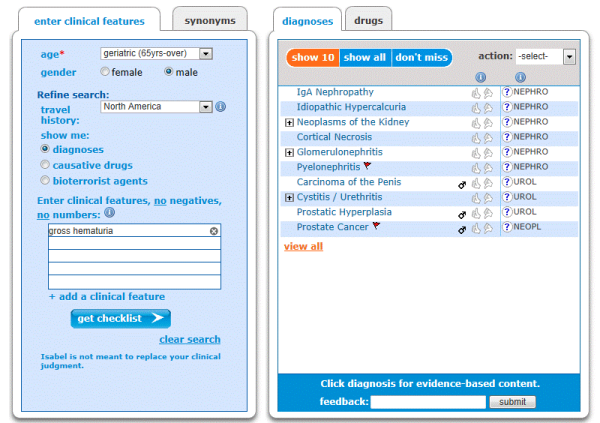- Privacy Policy
- Terms & Conditions
- Contact us
- ©Isabel Healthcare 2020
1 Minute Read: Hematuria Differential Diagnosis
Hematuria (haematuria) is the presence of red blood cells in the urine. Hematuria is caused by your kidneys allowing blood cells to leak into the urine. If only a small amount of red blood cells exist in the urine, then the urine color may not change and they may only be visible by using a microscope and this is termed microscopic hematuria. Gross hematuria (macroscopic hematuria) is the opposite term, and it can normally be seen that the urine is a different color maybe pink, red or cola-colored. Urine dipstick testing is highly sensitive for blood but lacks specificity, so to confirm microscopic hematuria or gross hematuria then urine microscopy should be used using a freshly voided midstream urine specimen.
Microscopic hematuria: Once this has been identified then the causes should be worked up and determined by taking a detailed patient history with the aim of identifying risk factors and whether the patient has undertaken recent exercise, sexual activity, has a urinary infection or is menstruating. If the patient is experiencing other symptoms then these should be evaluated or elicited from the physical examination. Other laboratory tests to carry out should include coagulation studies, ESR, creatinine and C-reactive protein. A urine culture should be performed to rule out urinary tract infection and in men prostate-specific antigen testing should be performed if the prostate is a concern.
Differential diagnosis for microscopic hematuria using isabel:
Glomerulonephritis: This is often associated with fever and if the patient has had a recent infection like streptococcus. They may also experience nausea, vomiting, edema, sore throat, rash, arthralgia, dark urine.
Cystitis: This is more common in women, and symptoms often increase with stress, menses or sexual intercourse and include urinary urgency, frequency and pressure/pain in pelvic/perineal area. Men may experience pain in the penis or scrotum.
Nephrolithiasis: The patient may experience flank or groin pain as well as microscopic hematuria.
Trauma: Commonly microscopic hematuria can be caused by trauma as a result of exercise, contusion to the costovertebral angle area or genitalia and sexual activity. Women should be asked if they were menstruating when the mid-stream urine sample was collected.
Gross hematuria: 1ml of blood in 1 liter of urine may cause urine discoloration when the patient has gross hematuria. Gross hematuria if transient or asymptomatic indicates a significant disease and should always be fully investigated. Blood clots may also be seen in the urine of patients with gross hematuria and may be painful to pass.
To properly evaluate the urine specimen then a fresh, midstream, clean-catch or catheterized urine specimen must be collected and sent for analysis. Older patients with painless gross hematuria should be considered at high risk for malignancy and urine cytology should be performed.
Differential diagnosis for gross hematuria using isabel:
IgA nephropathy: Occurs with recurrent macroscopic hematuria associated with upper respiratory tract infection. Urinalysis reveals red blood cell casts and mild proteinuria.
Kidney neoplasms: The patient may experience flank fullness, history of dialysis, smoking or renal cell carcinoma, polycystic kidney disease and weight loss.
Pyelonephritis: This is a common cause of gross hematuria and other symptoms which may occur are flank pain, fever, chills, nausea, vomiting, abdominal pain, suprapubic pain.
Prostate cancer: This tends to present in older male patients with obstructive voiding and weight loss as well as gross hematuria.

Mandy Tomlinson
Mandy has worked for Isabel Healthcare since 2000. Prior to this, she was a Senior Staff Nurse on the Pediatric Infectious disease ward and high dependency unit at one of London's top hospitals, St Mary’s in Paddington which is part of Imperial College Healthcare NHS Trust. Her experience in the healthcare industry for the past 28 years in both the UK and USA means she's a vital resource for our organization. Mandy currently lives and works in Scottsdale, Arizona.
Subscribe Here!
Recent Posts
Virtual Triage: Do more questions lead to better patient outcomes?
One of the common misconceptions related to virtual triage / symptom checker tools is that the more..Webinar: Using Virtual Triage To Transform Patient Access
Outdated contact centers are posing problems for today's health systems. As longer hold times..List Of Categories
- Differential Diagnosis Decision Support
- Differential diagnosis
- Symptom Checker
- Symptoms
- Medical Error
- Patient Disease Information
- Disease
- Diagnostic Decision Support
- Clinical Decision Support
- Isabel 1 Minute Read
- Diagnosis Error
- Diagnosis Skills Cases
- Healthcare Informatics
- Medical Education
- Patient Engagement
- Clinical Reasoning
- Evidence-based Medicine
- Symptom Triage
- Nurse Practitioner Education
- Nursing Decision Support
- Partnership
- Public Health
- COVID-19
- EHR
- Patient Empowerment
- Patient Safety
- rare disease

Start your FREE Trial today
Try the Isabel Pro DDx generator for 30-days - no payment card details required.






